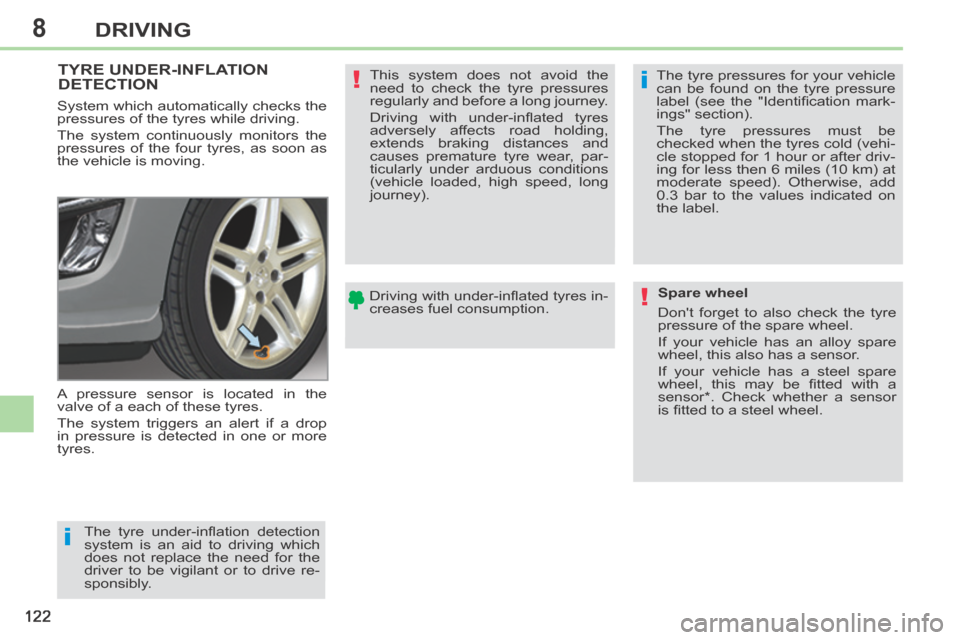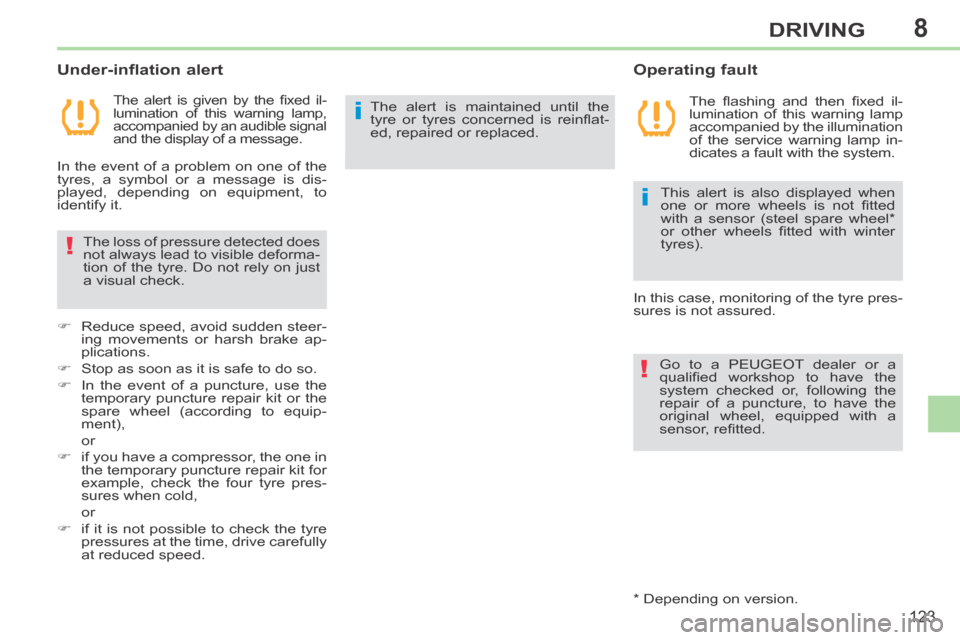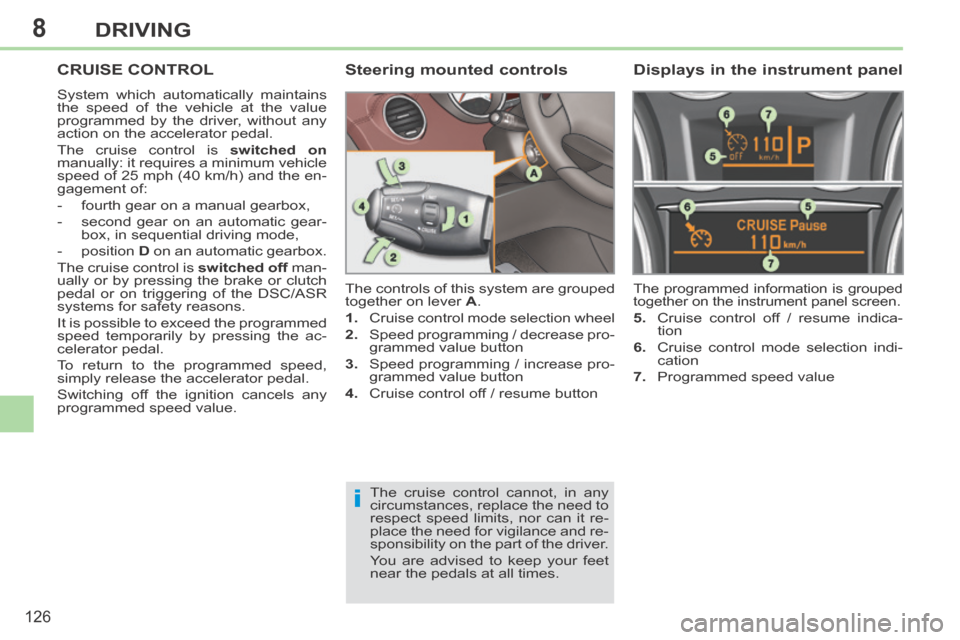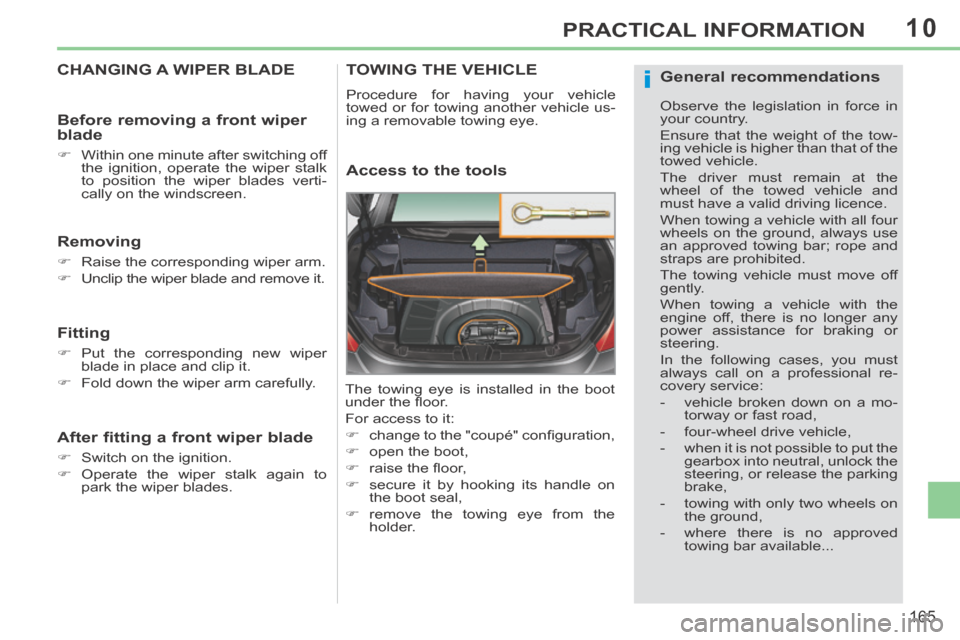four wheel drive Peugeot 308 CC 2014 Owner's Manual
[x] Cancel search | Manufacturer: PEUGEOT, Model Year: 2014, Model line: 308 CC, Model: Peugeot 308 CC 2014Pages: 268, PDF Size: 15.33 MB
Page 124 of 268

8
i
i
!
!
122
DRIVING
TYRE UNDER-INFLATION DETECTION
A pressure sensor is located in the
valve of a each of these tyres.
The system triggers an alert if a drop
in pressure is detected in one or more
tyres. This system does not avoid the
need to check the tyre pressures
regularly and before a long journey.
Driving with under-infl ated tyres
adversely affects road holding,
extends braking distances and
causes premature tyre wear, par-
ticularly under arduous conditions
(vehicle loaded, high speed, long
journey).
System which automatically checks the
pressures of the tyres while driving.
The system continuously monitors the
pressures of the four tyres, as soon as
the vehicle is moving.
The tyre under-infl ation detection
system is an aid to driving which
does not replace the need for the
driver to be vigilant or to drive re-
sponsibly. Driving with under-infl ated tyres in-
creases fuel consumption.
The tyre pressures for your vehicle
can be found on the tyre pressure
label (see the "Identifi cation mark-
ings" section).
The tyre pressures must be
checked when the tyres cold (vehi-
cle stopped for 1 hour or after driv-
ing for less then 6 miles (10 km) at
moderate speed). Otherwise, add
0.3 bar to the values indicated on
the label.
Spare wheel
Don't forget to also check the tyre
pressure of the spare wheel.
If your vehicle has an alloy spare
wheel, this also has a sensor.
If your vehicle has a steel spare
wheel, this may be fi tted with a
sensor * . Check whether a sensor
is fi tted to a steel wheel.
Page 125 of 268

8
i
!
i
!
123
DRIVING
The alert is given by the fi xed il-
lumination of this warning lamp,
accompanied by an audible signal
and the display of a message.
Operating fault
Under-inflation alert
The loss of pressure detected does
not always lead to visible deforma-
tion of the tyre. Do not rely on just
a visual check. The alert is maintained until the
tyre or tyres concerned is reinfl at-
ed, repaired or replaced.
The fl ashing and then fi xed il-
lumination of this warning lamp
accompanied by the illumination
of the service warning lamp in-
dicates a fault with the system.
This alert is also displayed when
one or more wheels is not fi tted
with a sensor (steel spare wheel *
or other wheels fi tted with winter
tyres).
Go to a PEUGEOT dealer or a
qualifi ed workshop to have the
system checked or, following the
repair of a puncture, to have the
original wheel, equipped with a
sensor, refi tted.
In this case, monitoring of the tyre pres-
sures is not assured.
Reduce speed, avoid sudden steer- ing movements or harsh brake ap-
plications.
Stop as soon as it is safe to do so.
In the event of a puncture, use the temporary puncture repair kit or the
spare wheel (according to equip-
ment),
or
if you have a compressor, the one in the temporary puncture repair kit for
example, check the four tyre pres-
sures when cold,
or
if it is not possible to check the tyre pressures at the time, drive carefully
at reduced speed.
* Depending on version.
In the event of a problem on one of the
tyres, a symbol or a message is dis-
played, depending on equipment, to
identify it.
Page 128 of 268

8
i
126
DRIVING
CRUISE CONTROL
System which automatically maintains
the speed of the vehicle at the value
programmed by the driver, without any
action on the accelerator pedal.
The cruise control is switched on
manually: it requires a minimum vehicle
speed of 25 mph (40 km/h) and the en-
gagement of:
- fourth gear on a manual gearbox,
- second gear on an automatic gear- box, in sequential driving mode,
- position D on an automatic gearbox.
The cruise control is switched off man-
ually or by pressing the brake or clutch
pedal or on triggering of the DSC/ASR
systems for safety reasons.
It is possible to exceed the programmed
speed temporarily by pressing the ac-
celerator pedal.
To return to the programmed speed,
simply release the accelerator pedal.
Switching off the ignition cancels any
programmed speed value. The controls of this system are grouped
together on lever
A .
1. Cruise control mode selection wheel
2. Speed programming / decrease pro- grammed value button
3. Speed programming / increase pro- grammed value button
4. Cruise control off / resume button
The programmed information is grouped
together on the instrument panel screen.
5. Cruise control off / resume indica- tion
6. Cruise control mode selection indi- cation
7. Programmed speed value
Steering mounted controls Displays in the instrument panel
The cruise control cannot, in any
circumstances, replace the need to
respect speed limits, nor can it re-
place the need for vigilance and re-
sponsibility on the part of the driver.
You are advised to keep your feet
near the pedals at all times.
Page 167 of 268

10
i
165
PRACTICAL INFORMATION
CHANGING A WIPER BLADE
Removing
Raise the corresponding wiper arm.
Unclip the wiper blade and remove it.
Fitting
Put the corresponding new wiper blade in place and clip it.
Fold down the wiper arm carefully.
Before removing a front wiper
blade
Within one minute after switching off the ignition, operate the wiper stalk
to position the wiper blades verti-
cally on the windscreen.
After fitting a front wiper blade
Switch on the ignition.
Operate the wiper stalk again to park the wiper blades.
TOWING THE VEHICLE
Procedure for having your vehicle
towed or for towing another vehicle us-
ing a removable towing eye.
Access to the tools
The towing eye is installed in the boot
under the fl oor.
For access to it:
change to the "coupé" confi guration,
open the boot,
raise the fl oor,
secure it by hooking its handle on the boot seal,
remove the towing eye from the holder.
General recommendations
Observe the legislation in force in
your country.
Ensure that the weight of the tow-
ing vehicle is higher than that of the
towed vehicle.
The driver must remain at the
wheel of the towed vehicle and
must have a valid driving licence.
When towing a vehicle with all four
wheels on the ground, always use
an approved towing bar; rope and
straps are prohibited.
The towing vehicle must move off
gently.
When towing a vehicle with the
engine off, there is no longer any
power assistance for braking or
steering.
In the following cases, you must
a lways call on a professional re-
covery service:
- vehicle broken down on a mo-torway or fast road,
- four-wheel drive vehicle,
- when it is not possible to put the gearbox into neutral, unlock the
steering, or release the parking
brake,
- towing with only two wheels on the ground,
- where there is no approved towing bar available...